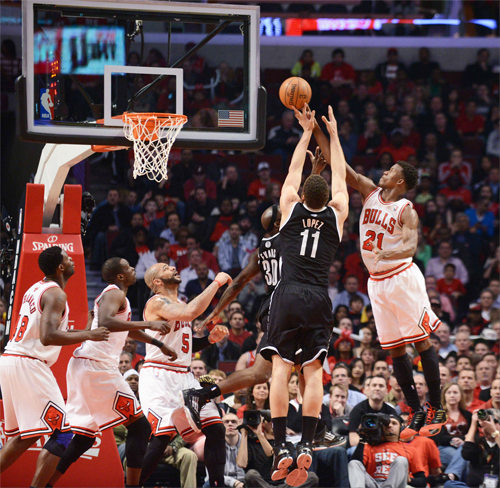Tom Thibodeau is a fairly low-key figure in professional basketball, but he just so happens to be one of the driving forces behind a significant shift currently underway among NBA franchises.
Moneyball hits the hardwood

Tom Thibodeau is a fairly low-key figure in professional basketball, but he just so happens to be one of the driving forces behind a significant shift currently underway among NBA franchises. Thibodeau was one of the architects of Boston’s championship season in 2008, where he was an assistant coach tasked with improving the team’s defense after coming over from Houston. He is now the head coach in Chicago and is responsible for the Bulls’ reputation as perhaps the most tenacious defensive team in the league. Thibodeau has garnered plenty of accolades over the last few years of playoff appearances by Chicago—he was named Coach of the Year in 2011—and his approach to the game is starting to rub off on other teams.
Playing without star point guard Derrick Rose for the entirety of the 2012–13 season, the Bulls nevertheless hustled their way to a 45-37 record and a No. 5 seed in the playoffs, getting past the Brooklyn Nets in seven games before falling to the Miami Heat in five. Many of the top teams in the NBA last year were known for their stifling defenses, including the Indiana Pacers, the Memphis Grizzlies and the Heat, who rattled off 27 straight victories during the regular season in large part because they committed to a renewed focus on the defensive end of the floor.
On the other end, intelligent and versatile offensive systems like those employed by San Antonio and Golden State are being closely studied by teams trying to find the right mix on their own rosters. General managers in the NBA are beginning to move away from the strategy of stockpiling big names in the hope that it might translate into playoff success, opting instead for a carefully considered blend of skills in order to compete in a league that is getting faster and more athletic every year.
These changes in philosophy have made it necessary for front offices to delve more into the statistical side of the game than they ever have before. Much like the “Moneyball” movement in Major League Baseball (named for the Michael Lewis book about the Oakland Athletics and their concentration on advanced statistics and probability when making roster decisions), professional basketball is undergoing a numbers revolution of its own.
NBA squads are looking closely at less-glamorous stats like field goal percentage, shot location and free-throw shooting, not to mention team offensive and defensive ratings. They’re finding out what works and what doesn’t, and they are assembling their rosters accordingly. To the casual fan, the outstanding level of play in the NBA over the last few seasons may seem like the logical result of an influx of top-shelf talent in recent years. But that’s only part of the story.
A good barometer is Allen Iverson’s MVP season of 2001. Voters that year chose to give the league’s most prestigious individual honor to an undersized guard who, while thrilling fans with his incredible scoring displays, chucked up a ton of shots, didn’t pass very much and therefore wasted a lot of his team’s possessions over the course of an 82-game season. Though players with Iverson’s athleticism and mental toughness will always have a place on an NBA roster, the reality is that the league is becoming a far unfriendlier place for players who are unable or unwilling to expand their production into other categories.
Look no further than Brandon Jennings, the 10th overall pick by the Milwaukie Bucks in 2009, who is currently among the last remaining free agents to be offered a new contract after a season in which the Bucks made it to the playoffs. And the reason behind many teams’ hesitation to sign the athletic point guard is clear: Jennings was one of the least statistically productive players in the league last season, posting an abominable shooting percentage and a highly inefficient assist-to-turnover ratio. He now finds the well drying up fast as franchises round up cheap, skilled role players who can be paired with incoming draft picks to establish long-term success.
It’s a different game these days, and it will likely look even more different in the years to come. But it’s a welcome change as the NBA begins to place a premium on those aspects of competition that have often been ignored at the highest level of the sport. However unsettling that might be for a fan accustomed to the way things were, it is clear that the league is headed in the right direction—forward.





